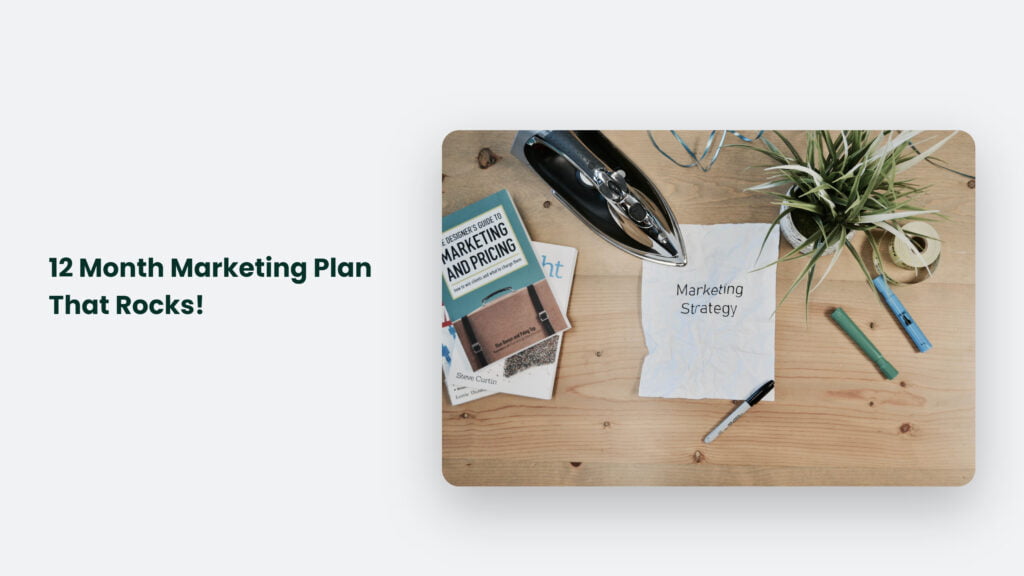Are you feeling overwhelmed by the thought of creating a 12-month marketing plan for your business? Don’t worry; you’re not alone! As a marketer, I know that creating a marketing plan can be daunting. But fear not! I’m here to guide you through the process and show you how to create a 12-month marketing plan that rocks!
Before we dive in, let me share a personal story with you. A few years ago, I worked with a small business owner who needed help to create a marketing plan. She knew her business inside and out, but she wasn’t sure how to translate that into a marketing strategy. After working together, we created a plan that helped her achieve her business goals, and I’m confident you can too.
Let’s get started!

Table of Contents
Setting Your Goals: What Do You Want to Achieve?
The first step in creating a marketing plan is to set your goals. Think about what you want to achieve in the next 12 months. Do you want to increase your website traffic? Generate more leads? Increase sales? Whatever your goals are, make sure they are specific, measurable, achievable, relevant, and time-bound.
Let me give you an example. Say your goal is to increase your website traffic by 30% in the next 12 months. That’s a great goal, but how will you achieve it? Break it down into smaller, more manageable tasks. For example, you might create a content strategy that includes weekly blog posts, social media updates, and email marketing campaigns.
Knowing Your Target Audience: Who Are You Trying to Reach?
The next step is to know your target audience. Who are you trying to reach? What are their pain points and challenges? What motivates them to buy from you? To understand your target audience, create buyer personas. A buyer persona is a detailed profile of your ideal customer. It includes their age, gender, location, interests, and buying habits.
Let me give you an example. Say you’re a business that sells organic baby food. Your target audience is likely to be new parents who are health-conscious and concerned about the ingredients in their baby’s food.
Knowing this, you can create marketing messages that resonate with your target audience and offer them solutions to their problems.
Conducting a Competitor Analysis: How Do You Stand Out?
To stand out in a crowded marketplace, you need to know what your competitors are doing. Conduct a competitor analysis to see what they’re doing well and where they fall short. Identify their strengths and weaknesses and look for opportunities to differentiate themselves from the competition.
Let me give you an example. Say you’re a local coffee shop competing with larger chains. You can differentiate yourself by offering a unique ambience, personalized service, and high-quality, locally sourced-coffee. Doing so can attract customers looking for a more authentic, personalized experience.
Defining Your Brand Identity: What Makes You Unique?
Your brand identity is what sets you apart from the competition and makes you unique. It includes your brand values, mission, and vision. Your brand identity should be reflected in all your marketing messages and visual elements.
Let me give you an example. Say you’re a sustainable clothing brand. Your brand identity should reflect your commitment to sustainability and social responsibility. Your marketing messages should emphasize reducing waste and promoting ethical manufacturing practices.
Creating a Content Strategy: The Foundation of Your Marketing Plan
Content is the foundation of your marketing plan. It helps you attract, engage, and convert your target audience. Your content strategy should align with your goals and target audience. It should include a mix of different types of content, such as blog posts, videos, infographics, and social media posts. Use a content calendar to plan your content for the next 12 months. It will help you stay organized and always have fresh, engaging content to share with your audience.
Let me give you an example. Say you’re a beauty brand. Your content strategy could include blog posts about the latest beauty trends, tutorial videos on how to apply makeup, and Instagram posts showcasing your products. By creating various content, you can attract different types of customers and keep your brand top-of-mind.
Planning Your Email Marketing Campaigns: Nurturing Leads and Driving Sales
Email marketing is a highly effective way to nurture leads and drive sales. Your email marketing strategy should include a lead magnet, welcome series, promotional campaigns, and newsletters. Your email marketing campaigns should be personalized and relevant to your target audience. Use email automation to save time and ensure that your emails are sent at the right time.
Let me give you an example. You can convert potential customers into loyal brand advocates by using email marketing to nurture leads. Say you’re a fitness studio. Your email marketing strategy could include a lead magnet such as a free workout plan, a welcome series that introduces new customers to your brand, and promotional campaigns that offer discounts on membership fees.

Optimizing Your Website for SEO: Driving Traffic to Your Site
Search engine optimization (SEO) is crucial to driving traffic to your website. Your website should be optimized for the keywords your target audience is searching for. It includes creating high-quality content, optimizing meta tags and descriptions, and building backlinks. Use analytics tools to track your website traffic and adjust your SEO strategies.
Let me give you an example. Say you’re a travel agency. Your website should be optimized for keywords such as “luxury travel packages” and “best travel deals.” By creating high-quality content that includes these keywords, you can attract more traffic to your site and increase your chances of converting visitors into customers.
Utilizing Paid Advertising: Reaching a Wider Audience
Paid advertising is a great way to reach a wider audience and drive conversions. Your paid advertising strategy should align with your goals and target audience. Identify the platforms you want to advertise on, such as Google Ads, Facebook Ads, or LinkedIn Ads.
Create highly targeted ad campaigns that use compelling ad copy and imagery to capture your audience’s attention. Use analytics tools to measure your ad performance and adjust your strategies.
Let me give you an example. You can use Facebook Ads to target local customers interested in food and dining out. Say you’re a restaurant looking to promote a new menu item. By creating a visually appealing ad that showcases your new dish, you can entice potential customers to visit your restaurant.
Using Social Media to Build Your Brand: Engaging with Your Audience
Social media is a powerful tool for building brand awareness and engaging with your target audience. Identify the social media platforms your target audience uses, such as Facebook, Instagram, or LinkedIn. Create engaging social media content that resonates with your audience and use social media ads to increase your reach. Use analytics tools to measure your social media performance and adjust your strategies as needed.
Let me give you an example. Say you’re a pet store. You can use Instagram to showcase your products and engage with your customers by featuring user-generated content, sharing cute pet photos, and running Instagram contests. Building a community around your brand can increase your brand loyalty and generate more sales.
Measuring Your Results: How Are You Performing?
The final step in creating a marketing plan is to measure your results. Use analytics tools to track your website traffic, open email rates, click-through rates, social media engagement, and conversion rates. Analyze your data regularly to see what’s working and what’s not. Use this information to make data-driven decisions and optimize your marketing plan for better results.
Be Flexible and Adapt to Changes: Staying Ahead of the Game
Marketing is an ever-evolving field, and what works today may not work tomorrow. Be flexible and adapt to changes in the market and consumer behaviour. Monitor industry trends and keep an eye on your competition to stay ahead of the game.
Let me give you an example. Say you’re a fashion brand. You notice that sustainability is becoming an important trend in the fashion industry. You can adapt your marketing plan by highlighting your commitment to sustainable fashion and showcasing your eco-friendly products. By staying ahead of the curve, you can attract customers looking for brands that align with their values.
Stay Within Your Budget: Maximizing Your Resources
Marketing can be expensive, and it’s easy to overspend if you’re not careful. Set a budget for your marketing plan and stick to it. Prioritize the marketing channels that are most effective for your business and allocate your resources accordingly.
Let me give you an example. Say you’re a startup with a limited marketing budget. You can focus on low-cost marketing channels such as social media and email marketing. You can maximize your resources and still achieve your marketing goals by prioritising these channels.
Frequently Asked Questions:
How long should my 12-month marketing plan be?
Your 12-month marketing plan should be as long as it needs to be to cover all the information you need. Typically, it will be several pages long, but don’t worry; it doesn’t have to be boring!
Do I need to be a marketing expert to create a 12-month marketing plan?
No, you don’t need to be a marketing expert to create a 12-month marketing plan. All you need is a willingness to learn and a passion for your business.
How often should I adjust my marketing plan?
You should adjust your marketing plan regularly, at least every quarter. It will help you stay on track and adjust your strategies as needed.
Conclusion:
In conclusion, creating a 12-month marketing plan can be manageable. Following the steps outlined in this article, you can create a comprehensive, effective marketing plan that drives traffic, leads, and sales to your business. Remember to set specific goals, know your target audience, conduct a competitor analysis, define your brand identity, create a content strategy, plan your email marketing campaigns, optimize your website for SEO, utilize paid advertising, use social media to build your brand, measure your results, be flexible and adapt to changes, and stay within your budget. And most importantly, remember to have fun with it! Happy marketing!




